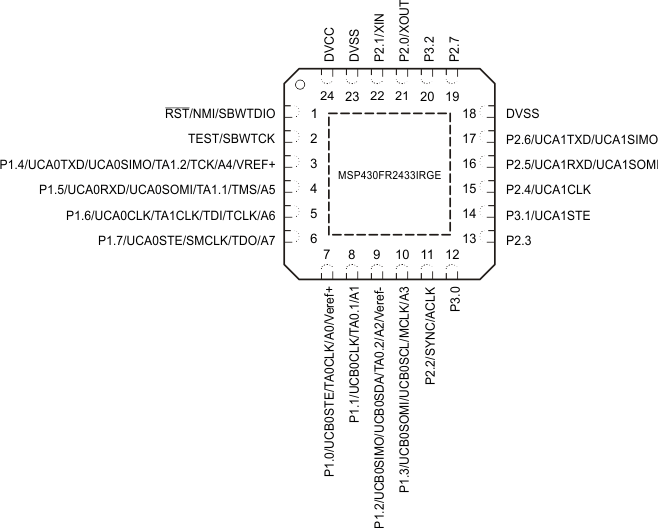SLAU739 October 2017
-
MSP430FR2433 LaunchPad™ Development Kit (MSP‑EXP430FR2433)
- Trademarks
- 1 Getting Started
- 2 Hardware
- 3 Software Examples
- 4 Resources
- 5 FAQ
- 6 Schematics
2.2.1 MSP430FR2433 MCU
The MSP430FR2433 is an ultra-low-power MSP430FRx FRAM-based microcontroller (MCU), which offer extended data logging and security capabilities. The MSP430FR2433 offers the small VQFN package (4 mm × 4 mm) in the FRAM microcontroller portfolio, combined with a variety of integrated peripherals and ultra-low power consumption. FRAM is a cutting edge memory technology, combining the best features of flash and RAM into one nonvolatile memory. More information on FRAM can be found at www.ti.com/fram.
Device features include:
- 1.8-V to 3.6-V operation
- 16-bit RISC architecture up to 16-MHz system clock and 8-MHz FRAM access
- 15KB of program FRAM, 512B of information FRAM, and 4KB of RAM
- 8-channel 10-bit ADC
- Four 16-Bit timers
- Two timers with three capture/compare registers each (Timer_A3)
- Two timers with two capture/compare registers each (Timer_A2)
- 32-bit hardware multiplier (MPY)
- 19 GPIOs
- Two enhanced universal serial communication interfaces (eUSCI_A) support UART, IrDA, and SPI
- One eUSCI (eUSCI_B) supports SPI and I2C
 Figure 4. MSP430FR2433 Pinout
Figure 4. MSP430FR2433 Pinout